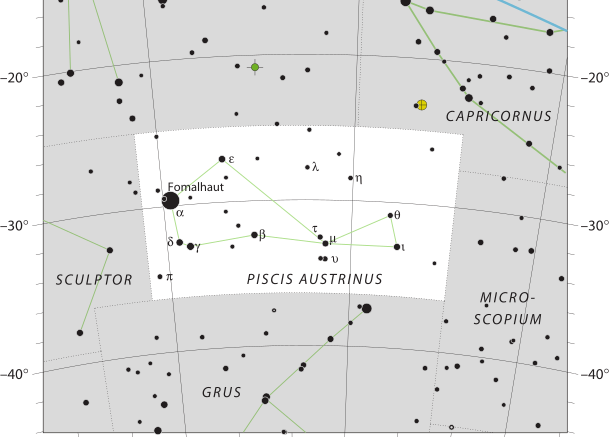Located in the southern hemisphere, the constellation Piscis Austrinus is Latin for “the southern fish.” This is different than the larger constellation of Pisces, which represents a pair of fishes.
Before the 20th century, the constellation was also known as Piscis Notius. The stars of the modern constellation Grus once formed the “tail” of Piscis Austrinus, but Petrus Plancius took these stars from Grus and forms a separate constellation.
Piscis Austrinus was one of the 48 constellations listed by the 2nd-century astronomer Ptolemy, and it remains one of the 88 modern constellations.
Its only star brighter than 4th magnitude is Fomalhaut, the 18th-brightest star in the night sky.
Piscis Austrinus is the 60th constellation in size, Piscis Austrinus contains two formally named stars. The star names are Fomalhaut and Sāmaya. The whole constellation is visible to observers south of latitude 53°N, which includes parts of the Pacific Northwest.
| Applicable Information | |
| Visibility In Pacific Northwest | July to November |
| Best Times To View | July and August |
| Right Ascension | 22h |
| Declination | −30° |
| Area | 245 square degrees |
| Main Stars | 7 |
| Brightest Object | Fomalhaut |
| Meteor showers | 0 |
| Messier objects | 0 |
| Neighboring Constellations | Capricornus, Microscopium, Grus, Sculptor, Aquarius |
History
The first mention of Pisces Austrinus was with the Babylonian civilization, as the Babylonians called the constellation the Fish. Piscis Austrinus was seen by the Ancient Greeks around 500 BC.
In Greek mythology, this constellation is known as the Great Fish and it is portrayed as swallowing the water being poured out by Aquarius, which is the water-bearer constellation.
Egyptian mythology said that the fish saved the life of the Egyptian goddess Isis, so she placed this fish and its descendants into the heavens as constellations of stars.
Stars
Within its borders, there are 47 stars brighter than or equal to apparent magnitude 6.5.
Although ancient astronomers had determined that 12 stars were members to Piscis Austrinus, Grus would incorporation 1 star and Microscopium would incorporate others.
When he was analyzing stars in the constellation, Bayer used the Greek letters alpha through mu to label the most prominent stars. Flamsteed would provide 24 stars Flamsteed designations; however, 4 of these stars would became part of constellation Microscopium.
There are several NGC objects that are galaxies that are in Piscis Austrinus that are worth noting. There is NGC 7172, which is visible in an 8″ telescope, which will appear as a fairly small but bright patch of light, with a bright, star-like nucleus. NGC 7174 is visible with an 8 inch telescope or larger given its magnitude of 12.15. The galaxy of NGC 7314 has a visible magnitude of 13.11, which means that telescopes of an aperture of 10 inches or more will be able to see it.
Make sure to check out other articles on the site, including a brief introduction to constellations, other constellation articles, and more!

Be the first to comment on "Piscis Austrinus"